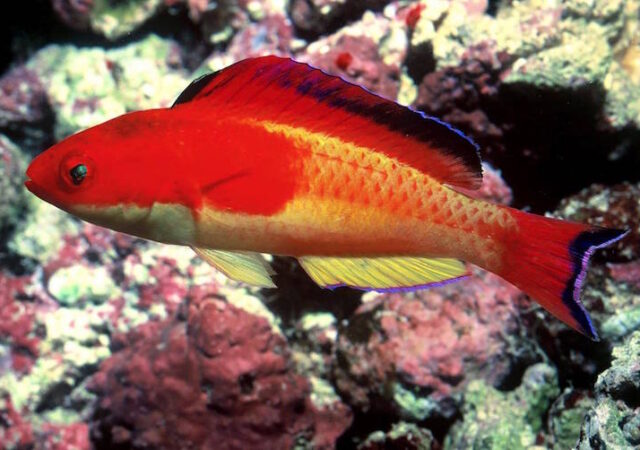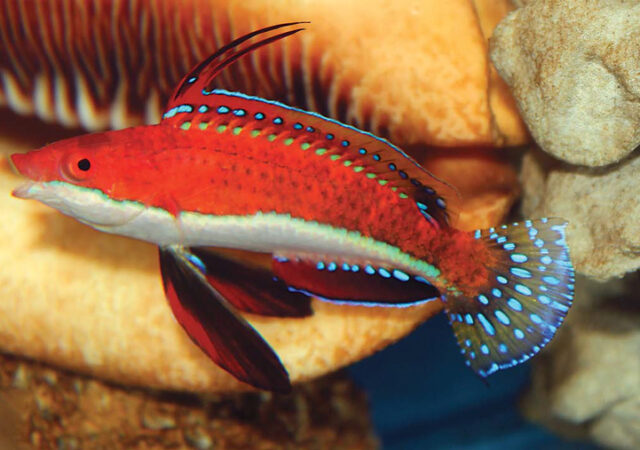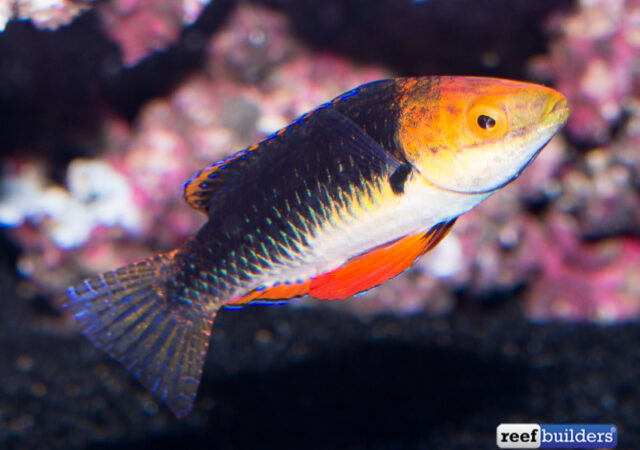Cirrhilabrus efatensis is a new species of fairy wrasse which was discovered living in Vanuatu in the South Pacific. This new species is in the small but distinct complex of hooded fairy wrasses which include C. bathyphilus, from the Coral Sea…
Cirrhilabrus rubeus & C. africanus Are The Two Newest Species of Fairy Wrasse
Cirrhilabrus africanus and C. rubeus are the two newest species of fairy wrasses that have been added to this quickly growing genus of reef fish. Descriptions of fairy wrasse species have been fairly frequent the last couple years, but today…
Face to Face with the Monsoon Fairy Wrasse
The Monsoon Fairy Wrasse is the newest species of Cirrhilabrus to be described, and the most recent that we’ve got to see in person. Cirrhilabrus hygroxerus was discovered by Monsoon Aquatics in Western Australia, but they brought a small group of…
Cherry Fairy Wrasse is an Exciting New Cirrhilabrus from the Philippines
樱桃仙女濑鱼是anew species of Cirrhilabrus which has just been discovered in the Philippines. The new fairy wrasse is wildly distinct from any known species of Cirrhilabrus, but shares a few similarities with some common, popular marine aquarium…
Cirrhilabrus hygroxerus, the Monsoon Fairy Wrasse Officially Described
Cirrhilabrus hygroxerus is the latin name of the newest species of fairy wrasse on the block, and it’s got a cool common name too. The monsoon fairy wrasse hails from the Timor Sea in Northwest Australia. The newly described Cirrhilabrus hydroxerus…
Cirrhilabrus isosceles finally gives the pintail fairy wrasse a name
Cirrhilabrus isosceles is the 51st member of the fairy wrasse genus, and one whose time to receive official scientific description has been long overdue. Long referred to as C. cf lanceolatus or the Pintail Fairy Wrasse, this is a fish that packs…
4.0 Cirrhilabrus laboutei & the Origins of Fairy Wrasse Diversity
At last, we’ve reached the thrilling conclusion to this comprehensive review of Fairy Wrasse evolution, and it’s time to once more dwell upon the topic of the group’s origins. As we’ve previously discussed, this enormously diverse genus can be comfortably categorized…
3.4 Fairy Wrasses: The filamentosus group
The filamentosus group presents the reader with a collection of familiar, aquarium-friendly species, many of which are exuberantly colored and morphologically quirky. Despite some superficial differences in colors and fin shapes, the overall morphology strongly implies that this is the…
3.3 Fairy Wrasses: The rubriventralis group
rubriventralis组有限元分析tures some of the most beloved and charming species of fairy wrasses, ornately adorned with painterly brilliance and morphological exuberance. Unlike some of the characteristically larger members of Cirrhilabrus, the rubriventralis group members remain small, rarely exceeding…
3.2 Fairy Wrasses: The temminckii group
The temminckii group plays host to some of the genus’ larger and more unappealing species. Burley, pugnacious and often glazed in matte grey, these un-fairy looking fairy wrasses are more often than not associated with the ugly duckling sobriquet. Despite…











